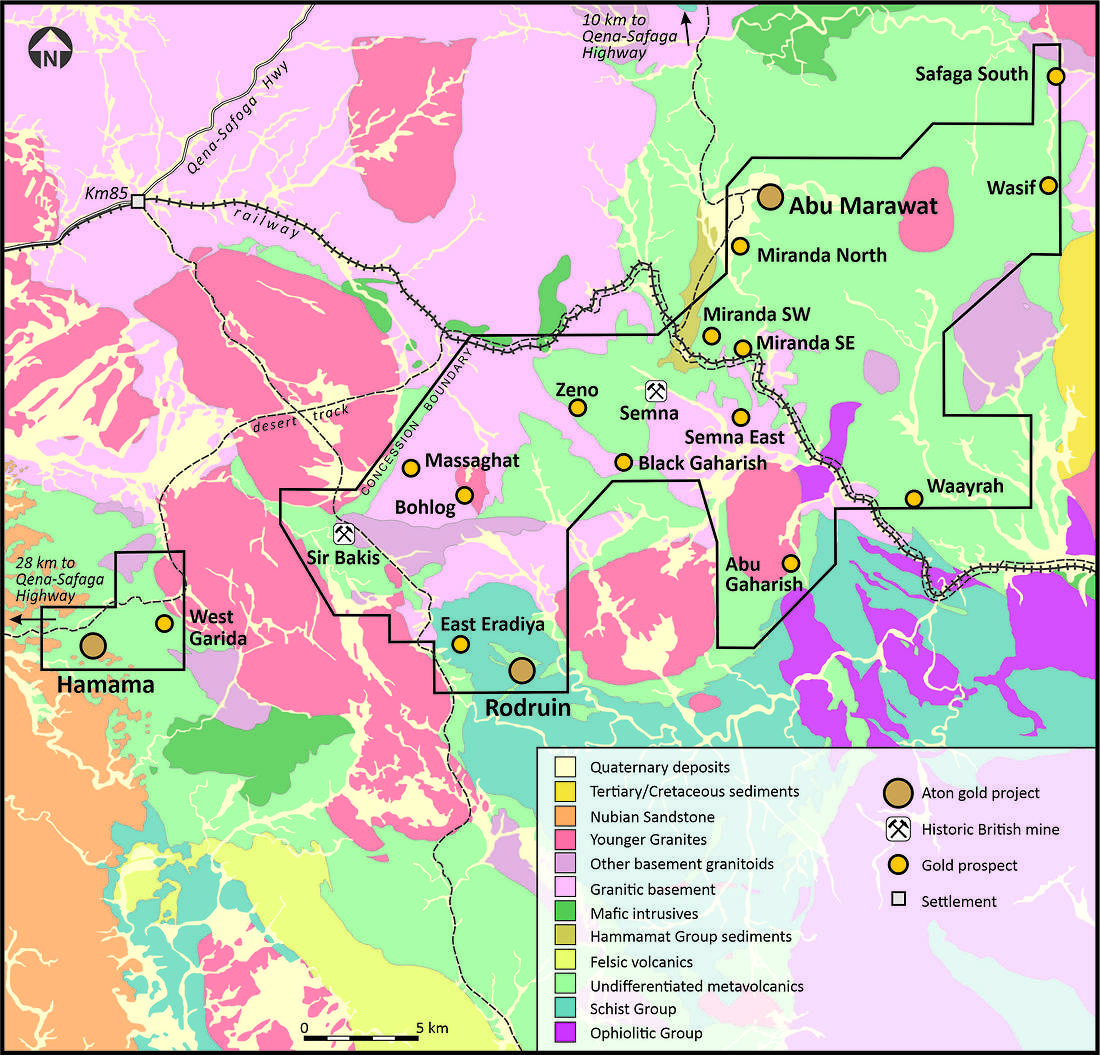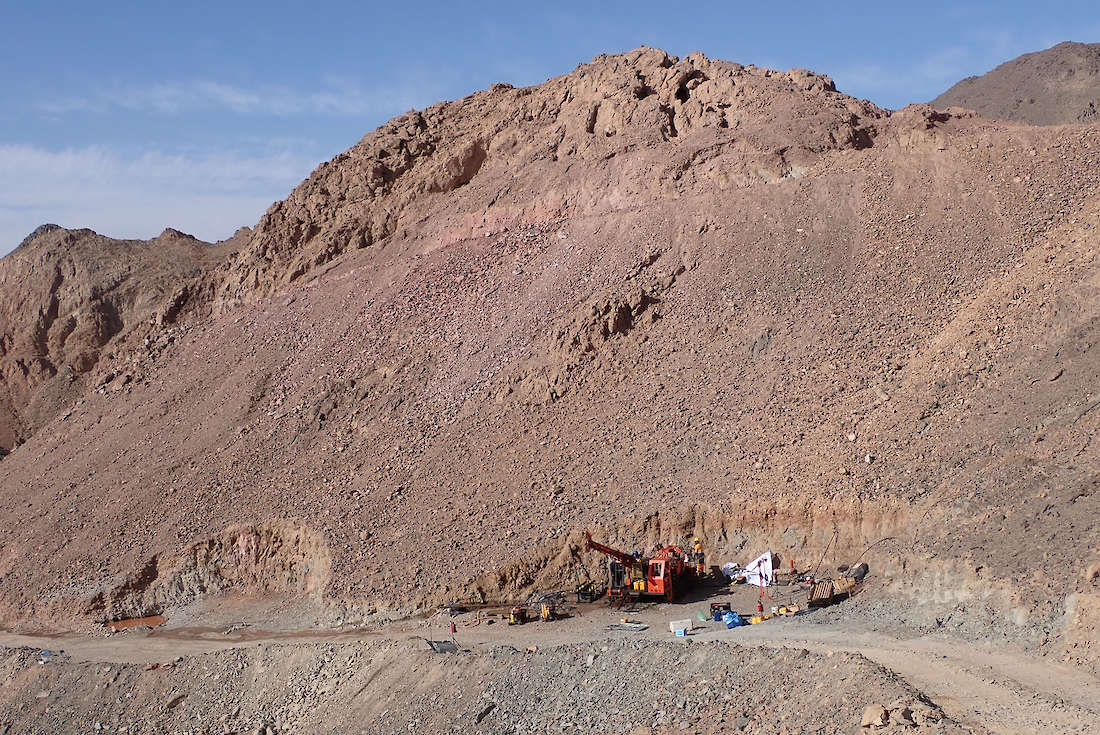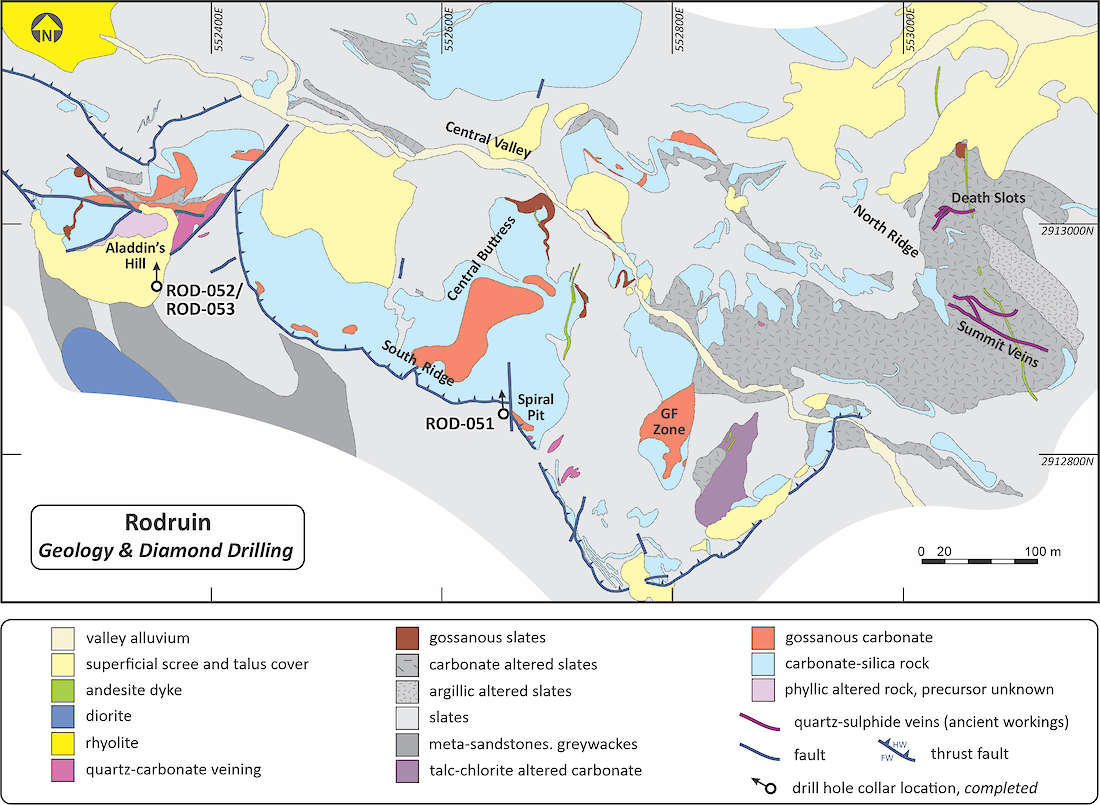Aton drills wide zones of near-surface mineralisation at Rodruin, including 1.97 g/t gold over 48m and 1.08m g/t gold over 38.85m from diamond drill hole ROD-052
Vancouver, British Columbia, January 25, 2022: Aton Resources Inc. (AAN: TSX-V) (“Aton” or the “Company”) is pleased to update investors on the first assay results from the Phase 2 diamond drilling programme at its Rodruin gold exploration project, which commenced in November 2021. Rodruin is located in the Company’s 100% owned Abu Marawat Concession (“Abu Marawat” or the “Concession”), in the Eastern Desert of Egypt.
Highlights:
- The first 10 drill holes for the programme have been completed to date, ROD-051 to ROD-060, for a total of 1,078 metres drilled. All holes so far have been drilled horizontally or at shallow angles in areas of rugged terrain, to test for potential near-surface mineralisation amenable to open pit mining methods. Results are now available from the first 3 holes completed;
- Hole ROD-051 returned a mineralised intersection of 47.15m grading 0.86 g/t Au and 10.0 g/t Ag;
- Hole ROD-052 returned mineralised intersections of 48.0m grading 1.97g/t Au and 5.3 g/t Ag, and 38.85m grading 1.08g/t Au and 7.4 g/t Ag, with mineralisation occurring over a near-surface horizontal width of c. 100m;
- Hole ROD-053 returned mineralised intersections of 29.3m grading 1.42g/t Au and 4.1 g/t Ag, and 18.5m grading 1.07g/t Au and 5.3 g/t Ag;
- Intersections from the first 3 diamond drill holes at Rodruin represent near-surface extensions of mineralisation outcropping at surface, which will be easily exploitable by open pit mining.
“We are very pleased with the results from the first 3 diamond drill holes at Rodruin, and this is just the start of what we are sure will be a very successful programme,” said Tonno Vahk, Interim CEO. “These results clearly indicate the potential for a large open pittable oxide gold resource at Rodruin, with the identification of broad zones of near-surface mineralisation. As this programme proceeds over the coming months we fully expect to be making rapid progress towards the identification, delineation and development of a very significant oxide gold resource at Rodruin, and as our geological understanding of the structural framework improves we also expect to be able to be able to unlock the full potential of the primary sulphide mineralisation first identified in the 2018 RC drilling programme. We firmly believe that we will be making great strides in 2022, and we are very much looking forward to working with our partners at the Egyptian Mineral Resources Authority towards developing new gold mines at both Rodruin and Hamama West.”
Rodruin diamond drilling programme
The Rodruin prospect was discovered in December 2017 by Aton geologists (see news release dated December 14, 2017), and is located approximately 18km east of the Company’s Hamama West mineral deposit (Figure 1). During 2018 Aton constructed a c. 4.5km access road to the prospect, and undertook a highly successful 50 hole Phase 1 reverse circulation percussion (“RC”) drilling programme at Rodruin, which included intersections of 36m @ 12.47 g/t Au from 5m downhole depth (hole ROP-003, see news release dated October 1, 2018), 163m @ 0.90 g/t Au from surface (hole ROP-017, see news release dated November 12, 2018), 40m @ 1.30 g/t Au and 13.5 g/t Ag from surface and 11m @ 5.20 g/t Au and 23.0 g/t Ag from 59m (both from hole ROP-032, see news release dated January 3, 2019), and 61m @ 1.55 g/t Au and 8.9 g/t Ag from 111m (hole ROP-050, see news release dated January 29, 2019).
Figure 1: Geology plan of the Abu Marawat Concession showing the location of the Rodruin project
In June 2021 the Company contracted Energold Drilling (EMEA) Limited to undertake an initially planned 3,350m Phase 2 diamond drilling programme at Rodruin (see news release dated June 14, 2021), with drilling commencing on November 22, 2021. The ID500-G track-mounted rig is able to drill horizontal and shallow holes (Figure 2), as well as more conventional inclined and vertical holes, and is ideal for the steep and rugged terrain at the Rodruin project. The programme has been designed to rapidly advance the project towards a maiden mineral resource at Rodruin in the shortest time frame possible, with the specific intention of drill testing much of the near-surface mineralisation identified in the 2018 Phase 1 RC programme, as well as resolving structural complexity.
Discussion of results
Diamond drill hole ROD-051 was drilled at the Spiral Pit Zone (“SPZ”), and holes ROD-052 and ROD-053 were drilled at Aladdin’s Hill (Figure 3). Collar and survey details of holes ROD-051 to ROD-053 are provided in Table 1.
Figure 2: Drilling on hole ROD-053, looking northwest. Much of Aladdin’s Hill above the rig is mineralised to surface, with ancient workings seen at the top
Figure 3: Geology plan of Rodruin, showing the location of diamond drill holes ROD-051 to ROD-053
Figure 4: Plan projection of diamond drill hole ROD-051
Hole ID | Collar co-ordinates 1 | Dip 2 | Grid azimuth 2 | EOH depth (m) | Comments | ||
X | Y | Z | |||||
ROD-051 | 552654 | 2912834 | 788 | 1.7 | 357.5 | 80.90 | SPZ / CBZ |
ROD-052 | 552353 | 2912946 | 758 | -0.5 | 358.4 | 149.50 | Aladdin’s Hill |
ROP-053 | 552353 | 2912946 | 758 | -20.6 | 360.2 | 127.30 | Aladdin’s Hill, abandoned early |
| |||||||
Table 1: Collar details of diamond drill holes ROD-051 to ROD-053
Spiral Pit/Central Buttress Zones
ROD-051 was drilled horizontally at the SPZ, immediately to the west of the north-south striking Spiral Pit Fault and was collared in unmineralised meta-sediments (Figures 3 and 4). The hole was designed to test potential mineralisation to the west of the Spiral Pit Fault, and under the summit of the South Ridge between the collar and the Central Buttress Zone (“CBZ”). The fault itself is mineralised with gold-bearing gossan outcropping in the downthrown block immediately to its east (see Figure 2 in news release dated, December 10, 2018).
ROD-051 returned a broad intersection of 47.15m grading 0.86 g/t Au and 10.0 g/t Ag from 33.75m (Table 2), in gossanous carbonate host rocks, confirming the presence of blind mineralisation under the South Ridge between the Central Buttress and the Spiral Pit Zones (Figure 4). The hole ended in mineralisation. This new mineralised interval is interpreted as being contiguous with mineralisation sampled at surface on the top of the South Ridge (see news releases dated February 6, 2018 and March 5, 2018) and also drilled from the CBZ in 2018, as well as the gossanous mineralisation offset to the east of the Spiral Pit Fault. Inclined RC holes drilled under the South Ridge returned intersections of 31m @ 2.45 g/t Au and 12.5 g/t Ag (ROP-034), and 34m @ 2.00 g/t Au and 8.5 g/t Ag (ROP-033), from gossanous carbonate host rocks (see news release dated January 3, 2019). Drilling to the east of the Spiral Pit Fault returned intersections including 20m @ 5.36 g/t Au and 15.9 g/t Ag from surface (hole ROP-029, see news release dated December 10, 2018).
Aton believes that the entire SPZ-CBZ area hosts a large block of gold(-silver) mineralisation associated with mineralised carbonate rocks which extends up to and outcrops on the top of the South Ridge. The presence of outcropping mineralisation in this area is further confirmed by recent surface channel sampling which returned a mineralised interval of 127m grading 1.33 g/t Au and 7.3 g/t Ag (channel profile ROC-031, see news release dated November 3, 2021).
Hole ID | Intersection (m) 1 | Au (g/t) | Ag (g/t) | Cu (%) | Pb (%) | Zn (%) | Comments | ||
From | To | Interval | |||||||
ROD-051 | 33.75 | 80.90 | 47.15 | 0.86 | 10.0 | 0.01 | 0.00 | 0.15 | To end of hole (EOH) |
ROD-052 | 17.20 | 19.70 | 2.50 | 1.17 | 4.4 | 0.02 | 0.00 | 0.07 | Aladdin’s Hill, hole sampled to 131.5m only, Ancient mining voids intersected |
27.00 | 75.00 | 48.00 | 1.97 | 5.3 | 0.10 | 0.07 | 0.42 | ||
92.65 | 131.50 | 38.85 | 1.08 | 7.4 | 0.06 | 0.01 | 0.58 | ||
ROP-053 | 29.80 | 59.10 | 29.30 | 1.42 | 4.1 | 0.07 | 0.05 | 0.07 | Aladdin’s Hill, ancient mining voids intersected |
96.80 | 115.30 | 18.50 | 1.07 | 5.3 | 0.10 | 0.02 | 0.35 | ||
| |||||||||
Table 2: Mineralised intersections from diamond drill holes ROD-051 to ROD-053
Figure 5: Schematic cross-section through Aladdin’s Hill, 552350E
Aladdin’s Hill
2 drill holes, ROD-052 and ROD-053 were drilled on section from the south side of Aladdin’s Hill (Figures 3 and 5), designed to test the potential phyllic-hosted mineralisation, and also gossanous carbonate associated mineralisation to the north and northeast of this zone.
Both drill holes intersected good zones of the phyllic-hosted mineralisation with ROD-052 returning an intersection of 48.0m grading 1.97 g/t Au and 5.3 g/t Ag from 27.0m, and ROD-053 returning 29.3m grading 1.42 g/t Au and 4.1 g/t Ag from 29.8m (Table 2 and Figure 5). These 2 holes confirm a ‘wedge’ of phyllic-hosted mineralisation at Aladdin’s Hill that extends to and is exposed at surface that had previously been identified in drilling (see news release dated October 1, 2018) and from surface sampling (see news release dated September 4, 2018). The phyllic-hosted mineralisation at Aladdin’s Hill consists of very heavily quartz-sericite-pyrite altered rock, interpreted as having a meta-sedimentary precursor, that is consistently mineralised, and contains high grade coarse gold bearing zones. RC drill hole ROP-003 returned an intersection of 36m grading 12.47 g/t Au and 9.3 g/t Ag (see news release dated October 1, 2018) from this block of phyllic-hosted mineralisation.
The phyllic-hosted mineralisation at Aladdin’s Hill is separated from gossanous carbonate associated mineralisation to its north and northeast by a zone of east-west faulting (Figures 3 and 5). Both holes ROD-052 and ROD-053 intersected significant widths of mineralisation north of the phyllic zone returning intersections of 38.85m grading 1.08 g/t Au and 7.4 g/t Ag from 92.65m (hole ROD-052) and 18.5m grading 1.07 g/t Au and 5.3 g/t Ag from 96.8m (hole ROD-053). Both holes intersected significant cavities, believed to be ancient underground mine workings associated with gossans, and hole ROD-053 had to be abandoned early, due to loss of circulation into extensive cavities, as it was entering a zone of mineralised carbonate. The mineralisation in this zone is associated with both gossanous carbonates and altered and gossanous meta-sediments, it contains higher levels of zinc, and is more typical of the mineralisation over the general Rodruin area, including that from hole ROD-051. This mineralisation is related to the wide intersection from RC hole ROP-017 (163m grading 0.90 /t Au and 7.4 g/t Ag from surface, see news release dated November 12, 2018), and also the sulphide mineralisation in ROP-050 (61m grading 1.55 g/t Au and 8.9 g/t Ag from 111m, see news release dated January 29, 2019).
Structure is very complex in this area with mineralisation localised by both structure and lithology. There appear to be 2 shallow north-dipping thrust faults in this area, with a series of other faults that displace the earlier thrusts, as well as folding of the carbonate and meta-sedimentary lithologies. It is anticipated that these complexities will be resolved as drilling proceeds.
Discussion
The results of these first 3 holes from the Phase 2 diamond drilling programme confirm the potential for a significant tonnage of near-surface open pittable oxide mineralisation at Aladdin’s Hill and on the South Ridge at Rodruin. Drill hole ROD-052 has intersected mineralisation over a horizontal width of at least 100m within 20-30m of surface, confirming the mineralisation identified at surface in both channel and grab sampling, and representing a very attractive and mineable target. Preliminary scoping level metallurgical testing has shown gold recoveries of up to 89.5% Au and 73.6% Ag from oxide material at Rodruin (see news release dated August 3, 2021), and has indicated that the gold is recoverable from both Rodruin oxide and sulphide mineralisation types.
Aton believes that there is a very significant tonnage of easily mineable oxide material associated with the gossanous carbonate outcrops at the Central Buttress-Spiral Pit and GF Zones, as well as northeast of Aladdin’s Hill, which is readily amenable to both open pit mining and conventional gold processing technology. The current diamond drilling programme has been designed with the objective of quantifying this potential resource, and it is Aton’s intention to move as rapidly as possible towards the definition of a maiden mineral resource estimate at Rodruin, based in part on the current drilling.
As the geological understanding of the structural framework at Rodruin improves this will also assist our exploration team in their assessment of the potential of the deeper primary sulphide mineralisation at Rodruin identified during the 2018 RC drilling programme. The current Phase 2 RC programme will also follow up on and further test the sulphide mineralisation.
A new access road up on to the North Ridge has also been completed, which will enable us to drill the hitherto untested high grade veins, which returned assays of up to 321 g/t Au (see news release dated February 6, 2018), later in this current programme. Ongoing channel sampling is also identifying the potential for further mineralisation on the North Ridge.
Sample processing and analytical procedures
Drill core was logged by Aton geologists, and marked up for cutting and sampling at the Rodruin core farm. Samples were typically selected over nominal 1m intervals, but as determined by the logged lithologies. The core was half-cut by Aton staff onsite at the recently constructed onsite Rodruin sample preparation laboratory.
Full half-core samples were collected and bagged up in cloth bags, weighed and crushed to -4mm onsite, and split to a nominal c. 250-500g sample size. The coarse crushed reject samples are retained onsite at the Rodruin sample prep lab.
The c. 250-500g dried, crushed and split samples were shipped to ALS Minerals sample preparation facility at Marsa Alam, Egypt where they were pulverised to a size fraction of better than 85% passing 75 microns. From this pulverised material a further sub-sample was split off with a nominal c. 50g size, which was shipped on to ALS Minerals at Rosia Montana, Romania for analysis.
Samples were analysed for gold by fire assay with an atomic absorption spectroscopy (“AAS”) finish (analytical code Au-AA23), and for silver, copper, lead and zinc using an aqua regia digest followed by an AAS finish (analytical code AA45). High grade gold samples (>10 g/t Au) were re-analysed using analytical code Au-GRA21 (also fire assay, but with a gravimetric finish). High grade Ag and base metal samples (Ag >100 g/t, and Cu, Pb and Zn >10,000ppm or >1%) were re-analysed using the ore grade technique AA46 (also an aqua regia digest followed by an AAS finish).
About Aton Resources Inc.
Aton Resources Inc. (AAN: TSX-V) is focused on its 100% owned Abu Marawat Concession (“Abu Marawat”), located in Egypt’s Arabian-Nubian Shield, approximately 200 km north of Centamin’s world-class Sukari gold mine. Aton has identified numerous gold and base metal exploration targets at Abu Marawat, including the Hamama deposit in the west, the Abu Marawat deposit in the northeast, and the advanced Rodruin exploration prospect in the south of the Concession. Two historic British gold mines are also located on the Concession at Sir Bakis and Semna. Aton has identified several distinct geological trends within Abu Marawat, which display potential for the development of a variety of styles of precious and base metal mineralisation. Abu Marawat is 447.7 km2 in size and is located in an area of excellent infrastructure; a four-lane highway, a 220kV power line, and a water pipeline are in close proximity, as are the international airports at Hurghada and Luxor.
Qualified person
The technical information contained in this News Release was prepared by Javier Orduña BSc (hons), MSc, MCSM, DIC, MAIG, SEG(M), Exploration Manager of Aton Resources Inc. Mr. Orduña is a qualified person (QP) under National Instrument 43-101 Standards of Disclosure for Mineral Projects.
For further information regarding Aton Resources Inc., please visit us at www.atonresources.com or contact:
TONNO VAHK
Interim CEO
Tel: +1 604 318 0390
Email: info@atonresources.com
Note Regarding Forward-Looking Statements
Some of the statements contained in this release are forward-looking statements. Since forward-looking statements address future events and conditions; by their very nature they involve inherent risks and uncertainties. Actual results in each case could differ materially from those currently anticipated in such statements.
Neither TSX Venture Exchange nor its Regulation Services Provider (as that term is defined in policies of the TSX Venture Exchange) accepts responsibility for the adequacy or accuracy of this release.





